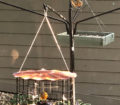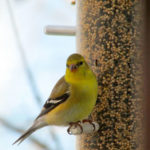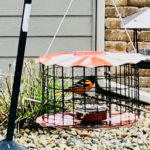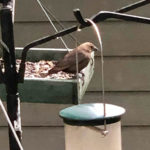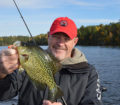By Darial Weisman
- A brightly colored male goldfinch enjoys a meal of seeds called Finch Delight. (Photo by Darial Weisman)
- A stray cowbird stops for a quick meal. (Photo by Darial Weisman)
- A male oriole takes advantage of the grape jelly. (Photo by Darial Weisman)
We have had quite the up and down weather conditions since early spring. Now, here we are entering the month of August and heading toward October! We just got through with some of the most oppressive heat in a long time with high humidity and temperatures rising into the mid-90s and heat indexes well over 100 degrees. Yet, as down as my husband and I become frustrated with the weather, it doesn’t stop our feathered friends.
No matter the weather, each day our spirits are lifted as we look out our south windows at our two bird feeding stations. From dawn to dusk, our feathered friends flit in and out. It is actually a bird menagerie. We have nine different feeders to attract a wide range of birds.
All but the hummingbird feeders hang from two poles, each with a squirrel baffle to stop the squirrels from getting into the seed. They just can’t get up above the baffle and they can’t make the leap from the oak trees, so we get to enjoy the squirrels, but they are relegated to picking up seed beneath the feeders!
First, we have an open platform feeder and a covered platform feeder in which we place an ample supply of cardinal attraction mix. Cardinals, of course, come to these two feeders, along with chickadees, nuthatches, downy woodpeckers, flickers, doves, robins and every once in a while, a stray brown-headed cowbird and grackle.
The cardinals are the shyest coming in the early morning, and any unusual movement sends them off. The tiny birds flit in and out, in and out throughout the day. It is the robin, though, that is probably the funniest. At one time, I thought robins ate only worms, insects and berries from shrubs. However, they also like fruit, peanut hearts and hulled sunflower seeds.
That’s why they come to our platform feeders. If it’s a sunny day, a visiting robin will plop itself right in the middle of the open platform feeder and sit there and eat, keeping the smaller birds away. If it is rainy, a robin will often take refuge under the covered platform feeder and just sit right in the middle keeping dry and enjoying its meal. Occasionally, an evening grosbeak will also frequent the platform feeders.
Doves will also come to the platform feeders and also pick up spilled seed off the ground, while juncos and chipping sparrows also hop around beneath the feeders picking up seeds.
Gold finches and house finches are attracted to our circular feeders filled with NutraSaff Safflower seed, a golden-brown seed that has 30 percent more oil content than regular white safflower seed. They also like a feed called Finch Delight. When the gold finches, especially the brilliant yellow males, land, they really catch our eye. This is especially true when you get 3-4 males on one feeder.
A wide variety of woodpeckers are attracted to our suet and peanut feeders.
Then there are the two caged grape jelly feeders set up especially for the orioles. They show up sometime between early and mid-May. Once they find the jelly, we have to fill the feeders pretty much every day. We put the cage around the jelly because there are lots of other birds that have a sweet tooth. We put a couple of wood perches for the orioles to land on. It takes a little while, but they soon figure out how to step from the wood perch into the feeder to access the grape jelly. One of the cages, though, we found the orioles would come to the feeder but hesitated to enter the cage. I suggested to my husband that the little squares of the cage might be intimidating, so he used a pliers to widen the squares just a little. Sure enough, it was as if the orioles were just waiting for that!
Finally, on the outside of two of our windows, we have a pair of hummingbird feeders. I will make my own hummingbird solution mixing one-part ordinary white cane sugar to four parts water, bringing it to a boil and then letting it cool before putting in the feeders. Extra sugar water can be kept in the refrigerator for up to two weeks. This solution needs to be changed as often as every two to three days during the heat of summer.
The hummingbirds are our little aerial acrobats! We will often have as many five or six coming in and out, stopping for a quick sip with new visitors buzzing in and chasing the one at the feeder away. This is an ongoing battle, so to speak.
Yes, no matter the weather or the time of day, our spirits are lifted by our feathered friends.


